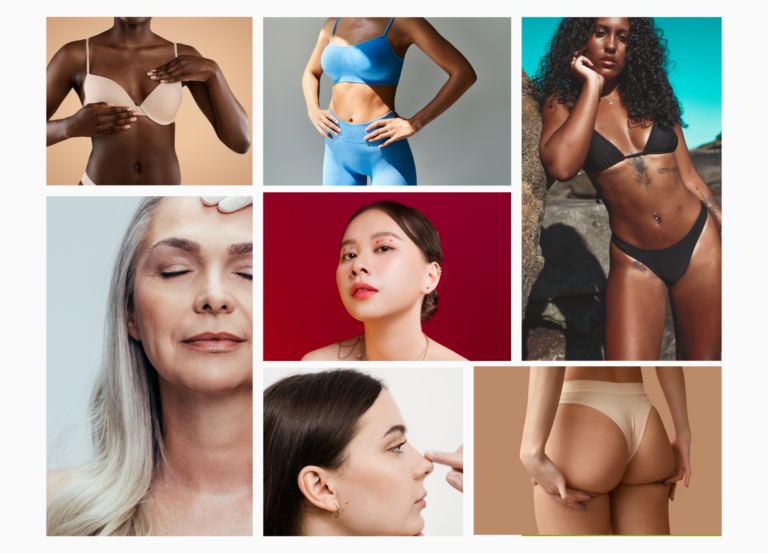The “Zoom boom” is real: nonstop video calls have led to an increased demand for all kinds of aesthetic treatments, from fillers and Botox to skin tightening and blepharoplasty to an array of neck-focused tweaks.
“The neck is an increased area of interest for many people because of the angles on Zoom,” explains Dr. Jennifer Levine, a board-certified plastic surgeon in New York City. “The position of the camera, especially if it is not at eye level, makes the neck look worse.” Also to blame, she says, is “tech neck,” which has become increasingly prevalent as the pandemic has increased our collective screen time.
“Working 24/7 at home and using the camera to communicate and socialize with others is making us acutely aware of the appearance of our necks—and as we continue to suffer through the pandemic, we continue to rely on these approaches,” says Dr. Yael Halaas, a board-certified plastic surgeon in New York City. “We’re still not spending money on travel or social gathering, so we are instead spending the money on improving our appearance.” And for those seeking an in-office fix that’s short of the classic facelift or neck lift, there are plenty of new, noninvasive treatments that will ensure this year is your neck’s best yet.
Patients come to plastic surgeons and dermatologists with complaints of sagging skin and jowls, fullness under the neck, fat under the chin (submental fat), skin laxity, lines and wrinkles along the neck, and loss of definition along the jawline. The treatment they may require will, of course, depend on their particular issues—but the most popular options include both surgical and noninvasive procedures. We’ve broken down some of the most common concerns when it comes to the neck and which treatments are best for each.
For mild lower-face laxity: Evoke
This past year has seen a number of new technologies come into the space. One is Evoke, a noninvasive, headset-like device that uses bipolar radiofrequency energy to reshape the lower face. “It’s the newest treatment for contouring the neck and jawline,” Dr. Levine explains. “It uses sustained radiofrequency energy in a treatment that is pain-free, with no downtime, and it has some immediate effects, so patients love it.” The device can also be tuned to destroy fat along with tightening the skin, adds Dr. Levine, who recommends three to six treatments, spaced one to two weeks apart.
Related: Neck Botox or Filler: What Are the Differences, and Which One Works Better?
For tech neck lines: neuromodulators
Injectables have always been obvious choices for treating the neck and have been used off label in the region for years. But now that U.S. Food and Drug Administration (FDA) approval for the use of Botox on platysmal bands is expected in 2021, it seems that toxins in the neck will soon be bigger business than ever. “Neuromodulators, like Botox, Dysport, and Xeomin, in the neck are important to add to any procedure, surgical or nonsurgical,” Dr. Levine says. “They help the neck look better by minimizing the bands and lines in the neck and prevent the depressive action of the platysma muscle.” While these injectables will never be a replacement for more invasive surgeries, they can help to address the lines that are associated with tech neck—both by treating those that are already there and preventing more from forming.
For moderate wattle and bands: MyEllevate
The separation of the neck muscle, known as platysmal bands, develop with age, and those with thin skin are even more prone to them. These have traditionally been a challenging concern to treat, but MyEllevate, a new minimally invasive procedure, shows promise. While other treatments address these issues on a surface level, MyEllevate was designed to treat the neck’s muscles and glands, which often lead to sagging and loss of elasticity. Patients with severe skin laxity would not be candidates for the treatment; however, it’s a great option for those with less significant signs of aging, experts say.
Performed under local anesthesia, MyEllevate uses surgical sutures to cut the bands in front of the neck and resuspend droopy muscles, glands, and skin under the neck to lift, sharpen, and contour. “The suture basically cuts the band so the top and bottom pieces lie flat,” explains Dr. Flora Levin, a board-certified oculoplastic plastic surgeon in Westport, Connecticut. “And [this is] combined with using the suture as a brassiere for the neck, to support the skin.”
MyEllevate results can vary, she says, and some patients will see improvement but not a total fix. “A good candidate is someone who is looking for an alternative to surgery, understanding that the results may not be as good,” Dr. Levin adds. Some bruising and swelling are to be expected—especially in the eight needle-puncture sites along the jawline and behind the ears—and patients have to wear a collar in order to restrict movement for the first few days, but downtime is minimal and usually lasts only about a week.
For excess fat: submental liposuction
Unwanted, stubborn fat along and under the chin is extremely common, but facial liposuction can deliver impressive results. Submental liposuction, or “chin lipo,” as it’s often called, uses a cannula to suction excess fat from the chin, neck, and jowls, and it is often combined with a skin tightening procedure in order to contour and define and generally avoid skin sagging. “Liposuction of the fat under the chin can be quite effective for treating a double chin,” says Dr. Umang Mehta, a board-certified plastic surgeon in Atherton, California. “In my practice, I have found that the majority of patients tolerate this procedure very well under local anesthesia, with or without mild sedation.” Submental lipo recovery is fairly minimal, and doctors typically recommend taking three to five days off from work and usual activities and taking it easy for about 10 days post-procedure. Patients also must wear a chin compression garment around the clock for the first week and at night for another week or two, making pandemic work-from-home circumstances ideal for this procedure.











